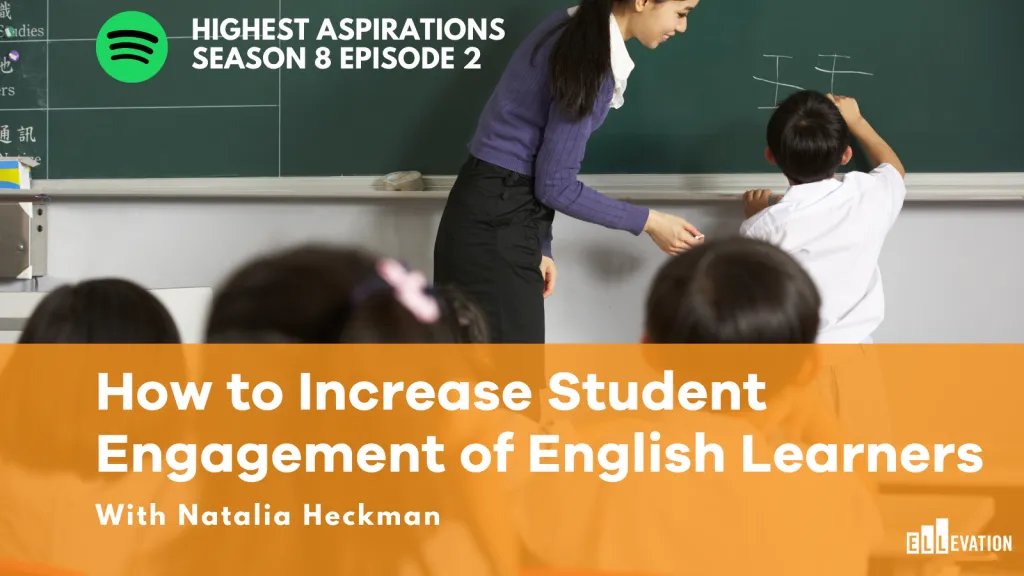3 Ways to Increase EL Engagement with Academic Language


3 Ways to Increase EL Engagement with Academic Language
Have you ever thought about all the words you recognize while reading or listening but never use when speaking or writing? Utilizing academic language while speaking might land you a job interview or impress your friends at a social gathering, but for English learners it can be the key to unlock academic opportunities that can lead them to future success. Feeling confident with the necessary vocabulary in a lesson will also lower their affective filter and increase participation.
Natalia Heckman, former English and ESOL Teacher, ESL/Bilingual Program Specialist, and current Education Consultant with Seidlitz Education, joined us on Highest Aspirations recently. She shared some great strategies teachers can use to help students transform passive vocabulary into active language that they can use in a variety of contexts. Here are three tips from the interview that you can use right away when scaffolding academic language:
Build time in lesson plans for conversation and practicing academic vocabulary.
We can all relate to how overwhelming and exhausting it can be to listen to uninterrupted speech during a class or a presentation. But this is a particular concern for multilingual learners who are trying to understand unfamiliar academic language. One of the most important things educators can do is to plan breaks by providing opportunities to practice the language they are hearing. The only way to do this consistently is by intentionally planning times for students to speak with one another.
“The only way to learn a language is through communication. And that communication will not happen without a culture of respect and collaboration in the classroom. So when we invest time into teaching kids how to work in pairs, work in groups, how to praise one another, how to take turns…we're actually investing time into the right thing.”
Offer repeated exposure to academic language to move it to their active vocabulary.
“Just hearing the word once does not transfer it from our passive receptive lexicon to the place where we can use it comfortably. So…it's really very helpful for me to have a framework for multiple forms of exposure.”
Mastering academic language involves repeated exposure and opportunities to play with new terms and phrases. Some strategies Natalia recommends include:
- Sketch or draw the word
- Match the word to synonyms or antonyms
- Play games like charades with the word
“For my students to truly internalize that language, they need to hear it more than once. And it will only happen if I set the standard and provide the structure for those conversations that will happen in my classroom.”
Build in structured conversations with differentiation to meet each students’ needs.
“If I have English learners in my classroom, they need different scaffolding. So we are not creating a different lesson or building three different lessons, one for each level of language. We are offering different types of scaffolds for students who may be at different language proficiency levels.”
Natalia notes authentic interaction using the language of the content and other speakers in the classroom is the best way for multilingual students to receive content rich instruction while also increasing their comfort levels with academic language.
Episode Resources:
- Marzano’s Six Steps
- The work of Dr. Spencer Kagan
- QSSSA Technique by Seidlitz Education
- Basically anything by Khaled Hosseini
- Breaking the Sound Barrier by Gianfranco Conti and Steve Smith
- Teaching MLs podcast by Tan Huynh
- seidlitzeducation.com
- nataliaesl.edublogs.org
Find the full episode transcript here.
Trained in Russia as a technical writer and a translator, Natalia never thought about becoming a teacher, but after her first year in a classroom, she knew that teaching was her calling and her mission. Natalia has taught English and ESOL classes, assisted teachers as an secondary ELA and Social Studies Instructional Coach, and served as an ESL/Bilingual program specialist. She currently pursues her passion for linguistics and education as an educational consultant with Seidlitz Education. The trainings she authored include “Moving ELs forward on EOC Writing” and “Building Better Sentences”. Natalia holds a bachelor’s degree in literature from the University of Houston at Clear Lake and a master’s degree in school administration from Lamar University.